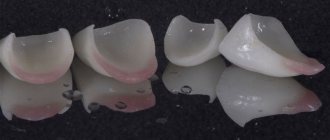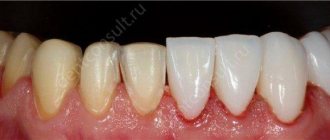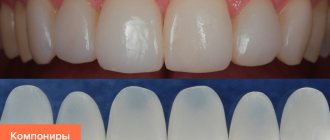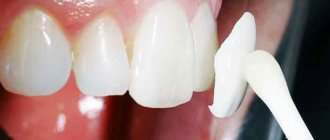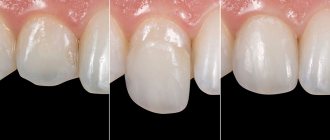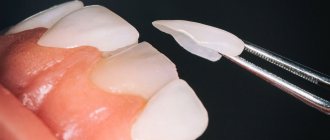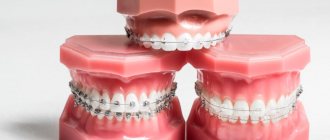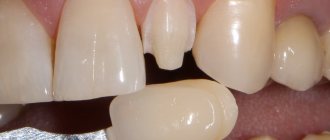Doctor's consultation Since the 30s of the last century, many Hollywood stars have used veneers to create a snow-white and attractive smile. And today microprostheses are actively used in dentistry.
Veneers are thin plates made of composite material or ceramics. They are fixed to the front side of the dentition.
Microprostheses are necessary in the following cases:
- When the color of the enamel changes due to depulpation or taking antibiotics;
- Removal and prevention of fluorosis and carious stains;
- In case of enamel erosion or the presence of cracks and chips;
- To correct gaps between teeth and to even out their shape;
There are two types of veneers: composite and ceramic.
Differences between composite and ceramic veneers
Veneers made of composite material are otherwise called direct - due to the method of creation. The doctor plays the record in 1.5 - 2 hours while the patient is in the dental chair. In some cases, an impression is taken of the teeth and the veneers are cast from the impression in the laboratory.
Direct veneers are extremely firmly connected to the tooth tissue, this is facilitated by the layer-by-layer technology of applying a composite to damaged enamel. It is impossible to tear the created plate from the foundation. The tightness of the composite veneer is extremely high - there is not the slightest gap between the base and the coating that could provoke the growth of pathogenic flora. At the same time, the composite veneer retains its plasticity and does not cause discomfort. Preserving color and transparency for many years, the prosthesis maintains the impression of the naturalness of the restored tooth.
Ceramic veneers or zirconium veneers are made exclusively in a dental laboratory using high-precision impressions. They are attached to the patient's teeth using a specially developed adhesive. There are several known methods for making ceramic veneers: pressing under pressure, casting on a refractor, cutting from a molded blank. These thin plates in finished form also very reliably imitate the appearance of human enamel, so correcting the aesthetics of a smile with such overlays is always successful.
What can be done using veneers?
Veneers effectively correct congenital and acquired defects of tooth enamel. For example, with their help you can easily hide fluorous spots, get rid of the appearance of “tetracycline” teeth, correct the color of darkened enamel or areas of enamel hypoplasia (hypocalcification).
In addition, veneers can eliminate chips and cracks that have formed on the teeth, and also give them the correct, desired shape. People who have diastemas and tremata (enlarged interdental spaces), which worsen the aesthetics of the appearance of the dentition, often resort to their use.
Features of direct veneers
People choose this restoration method for a number of reasons:
- It's inexpensive and fast. Composite veneers are installed in one clinic visit; there is no need to plan long-term treatment or schedule trips to the dentist. The cost of the composite is much lower than the production of ceramics.
- The removal of enamel from the surface of the teeth is extremely minimal, sometimes only required in places.
- There is a clear similarity between composite veneers and the enamel of natural teeth.
- It is attracted by the high adhesion of the artificial material to living tissues.
The technique has some disadvantages:
- The quality of the final composition greatly depends on the experience and qualifications of the doctor. This drawback, however, is inherent in any result of a dentist’s work.
- Tarnishing of a record over the years. It can be eliminated by polishing the veneer once every six months.
- Changes in the color of the veneer due to frequent consumption of coloring foods and drinks. Cannot be corrected.
- Corrosion of a composite veneer under the influence of ethanol occurs with regular drinking of alcohol and when rinsing the mouth with alcohol-containing rinses.
Which ones to choose?
It cannot be said unequivocally that ceramic veneers are better than composite ones. Each case should be considered individually. Dentists recommend choosing veneers based on the condition of the teeth, the nature of the defect, the desired result and financial capabilities.
If it is necessary to restore 1 or 2 teeth, you can absolutely confidently install composite veneers. If the restoration is carried out by an experienced specialist, then with the help of a composite you can get an excellent aesthetic result. It would take too much time to restore all the front teeth.
If the patient wants to get a “Hollywood smile”, then it is planned to install veneers on each tooth in the frontal area. In addition, such veneers should be as similar as possible to natural enamel and have a white tint. In this case, restoration with ceramic veneers only is considered; such a result cannot be achieved with a composite.
You should also choose veneers based on your financial capabilities. One composite veneer has a significantly lower cost than ceramic. But after 3-5 years it will be necessary to resort to restoration again, while the ceramics will last at least 10 years.
To summarize, we can conclude: if it is necessary to hide a minor defect of 1-2 teeth, you can safely resort to direct restoration. If you want an impeccable result, correction of a large number of teeth and sufficient financial resources, it is better to give preference to ceramic veneers. It is important to remember that there may be contraindications to a particular restorative material or method of its application. It is necessary to choose a method for installing veneers together with a specialist.
Pros and cons of ceramic veneers
The advantages of silicon oxide overlays are obvious:
- Lack of ability to oxidize, change color, or degrade. Ceramic veneers do not absorb pigments from food and do not disintegrate under the influence of acids and alcohols. They will not show any stains or discoloration throughout their entire service life.
- Ceramic veneers will last for more than a decade if initially installed correctly and handled with care.
- The plate is very durable, despite its microscopic thickness, not reaching even a millimeter.
- Imitation of enamel is the best among other veneering techniques.
Flaws:
- The cost of ceramic veneers is not affordable for every patient.
- The impossibility of quick prosthetics sometimes becomes extremely difficult. A person will have to visit the clinic at least twice: to take impressions and for final installation. In addition, you will have to spend money on making a temporary structure, which will need to be worn until the permanent veneers are glued.
- When preparing teeth for veneers, the doctor may overheat the tooth pulp, which can lead to inflammation and acute toothache.
Porcelain veneers require grinding down of the teeth. Composite veneers do not have high strength and durability. There is a better alternative to all options: install veneers without grinding your teeth Luxneers
Life time
Veneers, like no other element of prosthetics, have often become the subject of scientific research and experimentation. It seemed too implausible even to dentists that the thinnest plates could someday seriously compete with crowns. But time after time, researchers got the same result:
- the average service life of a composite plate is 5 years, subject to regular grinding and polishing;
- porcelain veneers will almost certainly last 10-15 years.
Patients often request replacement of composite veneers after 2-3 years. The most common reason is darkening of the material. But if you treat ceramic plates with care, they may not need to be replaced and will last much longer than their average service life. Since the main reasons for their failure are chips, cracks, fractures resulting from injury or personal negligence.
In 2007, scientists began a large-scale study. It involved 300 patients with ceramic veneers. After 10 years, in 91% of patients the plates retained their original appearance. According to the plan, the next examination is scheduled for 2022, and scientists predict that ceramic veneers will remain intact in 73% of patients.
Reasons for installing veneers
If one or two teeth require restoration, it is more profitable to install composite veneers, but ceramics are not at all prohibited. If there are many cosmetic defects and you need to cover three or more teeth, it is advisable to use porcelain veneers.
General indications for veneering:
- Masking darkening of enamel, the presence of erosive areas, small chips and cracks, stains.
- Correction of hypersensitivity of teeth.
- Improving the appearance of the tooth after treatment of pulpitis or caries. Behind the veneer, like behind a shield, it is possible to hide fillings and tooth darkening as a result of nerve removal.
- Changing the shape of the tooth, giving the effect of uniformity in the row.
- Covering interdental spaces and wide crevices.
When choosing to improve the aesthetics of your smile with veneers, you will have to follow the instructions of your dentist. The doctor has the right to refuse to place veneers on the patient if the following diseases are traced in the anamnesis:
- Bruxism (uncontrollable night grinding of teeth);
- Deformation of gum tissue, periodontal disease, gingivitis, poor sanitary condition of the oral cavity;
- Too massive fillings on the teeth, exceeding the volume of remaining living tissue;
- Malocclusion;
- Allergy to components of the composite mass.
Do you still think that veneers without grinding of teeth Luxneers or composite are better?
Make an appointment
Or call +7(985)532-21-01
What's more expensive?
On average, the price of a ceramic veneer in dental clinics in the capital is almost 2 times higher than the cost of installing a composite onlay. This is understandable, because at least 2 specialists work on creating the plate: a dentist and a dental technician. And in addition to paying for their services, the cost of ceramic veneers also includes depreciation of expensive laboratory equipment and the cost of purchasing the consumables themselves.
It’s easier with composite veneers, since they are made directly in the patient’s mouth by the dentist himself. And since the final result largely depends on the skill of the doctor, the price varies greatly from clinic to clinic. You can get a composite veneer installed by a novice doctor much cheaper than by a professional with a capital “P.” But will the result justify itself?
Differences
Composite and porcelain veneers differ in many ways.
- Material. Componers are made from a special filling material, and their creation does not require the participation of outside specialists or a dental impression. Ceramic plates are formed from ceramics (porcelain) and production is carried out under special conditions.
- Production time. Componers have a ready-made base. They can be “tailored” to an individual patient during one visit to the dentist. Porcelain onlays require first making an impression of the teeth, from which they are subsequently made. This process may take several weeks.
- Installation method. The composite material is applied to the surface of the tooth, after which it is treated with a certain light (polymerized). Conventional onlays are glued to the enamel using a cement base.
- Lifetime. Componers have appeared in dentistry relatively recently; their service life is about 3 years. If you follow the wearing rules, it may be larger. Porcelain microprostheses last 10 years or more.
- Price. Prices for installing corrective onlays vary and depend on the clinic, the professionalism of the dentist, the region and the material used. There is a big price difference between componeers and porcelain onlays. The cost of composite material for one tooth is about 10 thousand rubles. Ceramics for one incisor costs almost 3 times more.
- Properties. The filling material is of lower quality. This is explained by the fact that componeers wear out faster, and darkening occurs on them over time. Ceramics last longer. With proper care, it does not darken for a long time, and damage does not appear on it.
- Feel. Consumer reviews say that componeers are less comfortable than veneers. The first coating option is rougher.
Where is the best place to place veneers?
It's no secret that aesthetic operations such as the installation of veneers should be carried out only in serious and trusted clinics. From the best specialists. They are professionals in their field, with thousands of successfully performed veneering and aesthetic dental restoration operations behind them.
Why do we offer installation of veneers here, in our clinics?
All-Russian
The rating of private dental clinics in 2022 confirmed
the leadership
of the German Implantology clinics and the “Clinic over 3 years old”.
11,000 of the best
Russian dental clinics from more than 110 cities fought for the right to be the first, and we again became the best in Russia!
The award ceremony took place on September 23, 2022
within the framework of the largest dental exhibition in Russia -
DENTAL EXPO 2019
and
on September 22, 2022
at the
DENTAL EXPO 2020
.
In the category “Clinics up to 3 years of age” - the clinic of the Research Center in Ramenki:
In the category “Clinics over 3 years old” - the clinic of the Scientific Research Center on Kievskaya,
which has been successfully performing dental implantation for more than 9 years:
